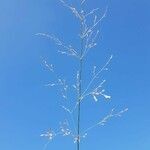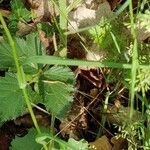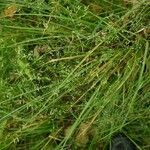Culms loosely tufted, 40–80(–120) cm tall, erect or slightly geniculate, rarely branching near base; nodes 5 or 6, uppermost at or above middle of culm. Shoots extravaginal. Leaf sheath smooth or rarely scabrid; equal to or shorter than blade; blade flat, 8–20 cm × 2–3(–5) mm; ligule 2–3 mm. Panicle slightly contracted, 10–20(–30) cm; branches obliquely ascending, 3–8 per node, basal primary branch 1/2–2/3 as long as panicle with spikelets in distal 1/2. Spikelets ovate-oblong, yellowish green, 2.5–5(–7) mm, florets (2–)3–5(–7); rachilla scabrid or warty, rarely smooth; glumes almost equal, 2–3.5(–4) mm; lemma 3–3.5(–4) mm, keel shortly villous for 1/2 of length, marginal veins for 1/3, apex golden or rarely silvery, membranous; callus webbed; palea keel scabrid, area between keels smooth and glabrous. Anthers 1.2–1.5(–2) mm. Fl. Jun–Jul. 2n = 28, 30, 32, 42.
Culms stout, loosely tufted from a purplish, often somewhat decumbent base, 5–15 dm, without rhizomes; lvs 1–2 mm wide; ligule ovate or triangular, 2.5–5 mm; infl declined or nodding, 1–3 dm, fairly open, its branches in sets of ca 5, bearing numerous spikelets at and beyond the middle; spikelets 2–4-fld; glumes lance-ovate, the first 1.9–2.7 mm, the second 2–3.1 mm; lemmas 2.1–3 mm, 3-veined or with an obscure additional pair of veins, webbed at base, hairy on the lower half or two-thirds of the veins, glabrous or scabrous toward the golden tip; rachilla glabrous; anthers 0.8–1.2 mm; 2n=28, 42. Wet meadows and damp soil; circumboreal, s. to Va., Mo., and N.M.








